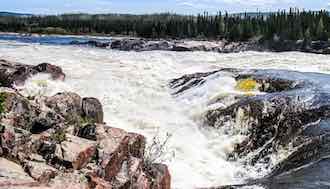By American Chemical Society —— Bio and Archives--December 27, 2016
Global Warming-Energy-Environment | Comments | Back To Full Article
 Hydroelectricity is a renewable energy, and the facilities that produce it give off less greenhouse gases than other power plants. But damming bodies of water can lead to the production and release of methylmercury from the soil. This toxic compound can move up the food chain and potentially harm human health. In the ACS journal Environmental Science & Technology, researchers quantify the possible increases in methylmercury exposures for indigenous communities living near planned facilities.
Bacteria can convert mercury, which occurs naturally in the soil, to methylmercury when the land is flooded, such as when dams are built for hydroelectric power generation. Unlike mercury, however, methylmercury moves into the food chain. People exposed to the chemical through their diet face increased cardiovascular risks, and children with high prenatal exposure can develop attention deficit/hyperactivity disorder, neurological abnormalities and other symptoms.
Hydroelectricity is a renewable energy, and the facilities that produce it give off less greenhouse gases than other power plants. But damming bodies of water can lead to the production and release of methylmercury from the soil. This toxic compound can move up the food chain and potentially harm human health. In the ACS journal Environmental Science & Technology, researchers quantify the possible increases in methylmercury exposures for indigenous communities living near planned facilities.
Bacteria can convert mercury, which occurs naturally in the soil, to methylmercury when the land is flooded, such as when dams are built for hydroelectric power generation. Unlike mercury, however, methylmercury moves into the food chain. People exposed to the chemical through their diet face increased cardiovascular risks, and children with high prenatal exposure can develop attention deficit/hyperactivity disorder, neurological abnormalities and other symptoms.The Comment section of online publications is the new front in the ongoing Cancel Culture Battle.
Big Tech and Big Media are gunning for the Conservative Voice—through their Comment Sections.
Canada Free Press wishes to stay in the fight, and we want our fans, followers, commenters there with us.
We ask only that commenters keep it civil, keep it clean.
Thank You for your patience and for staying aboard the CFP ‘Mother Ship’.
READ OUR Commenting Policy